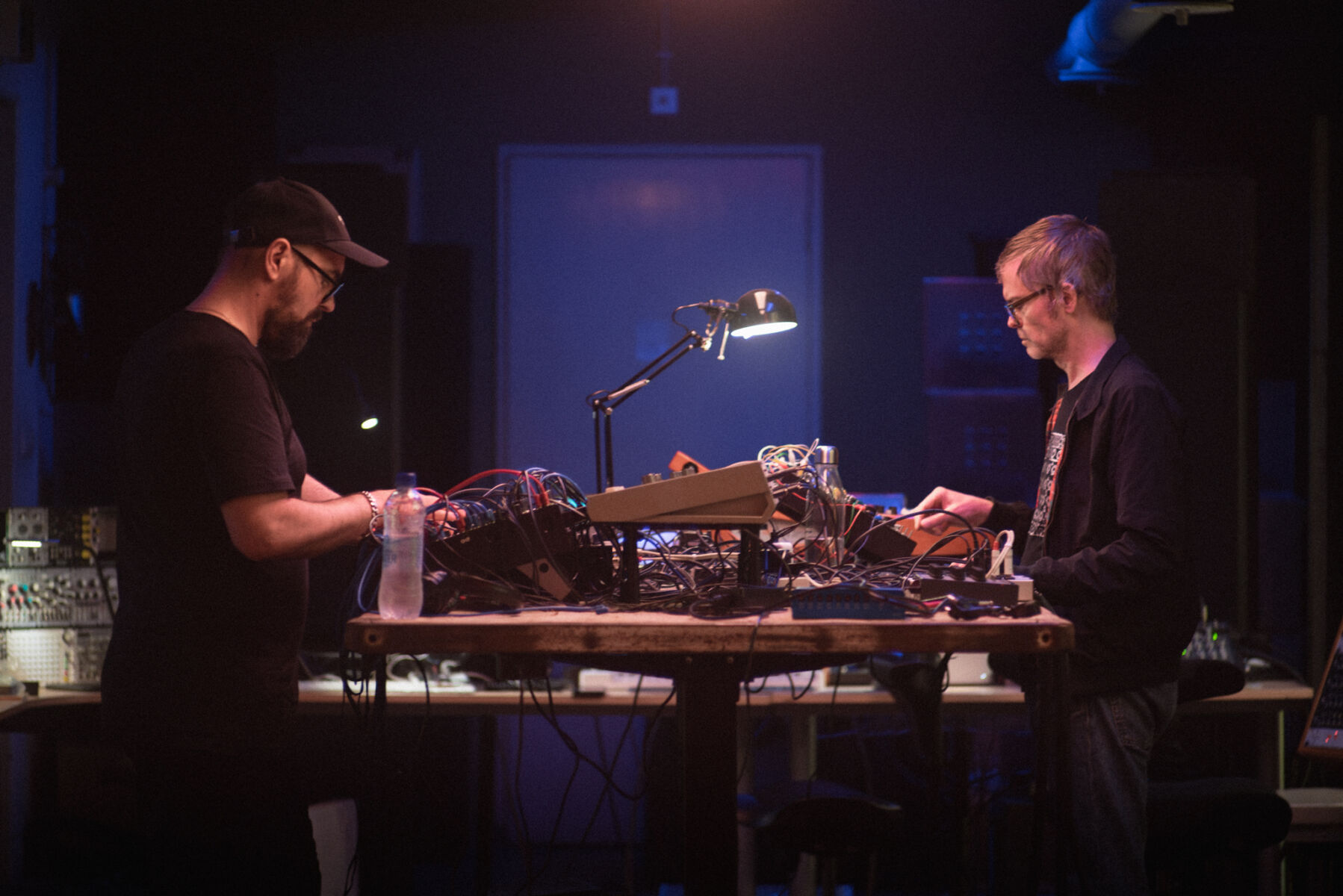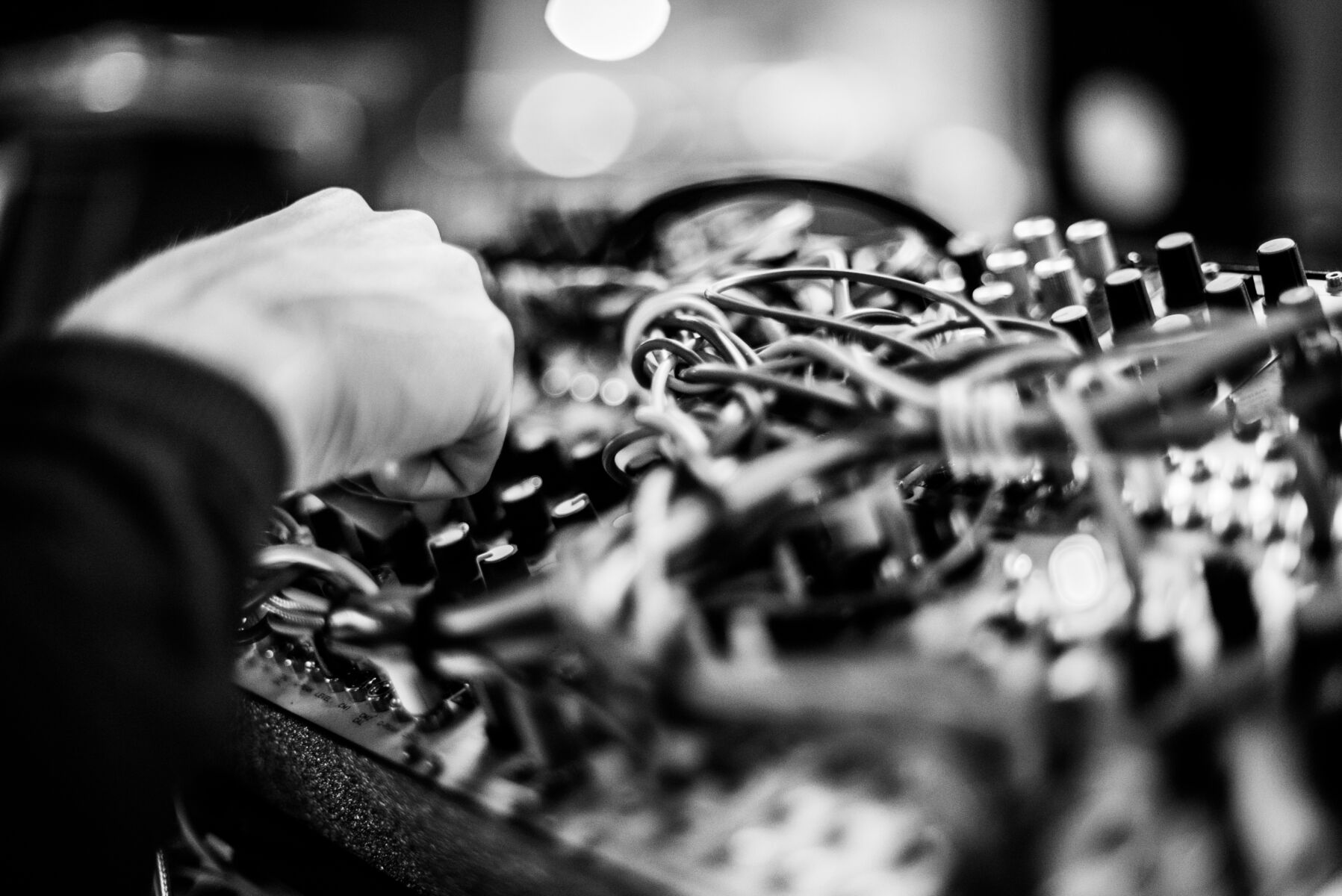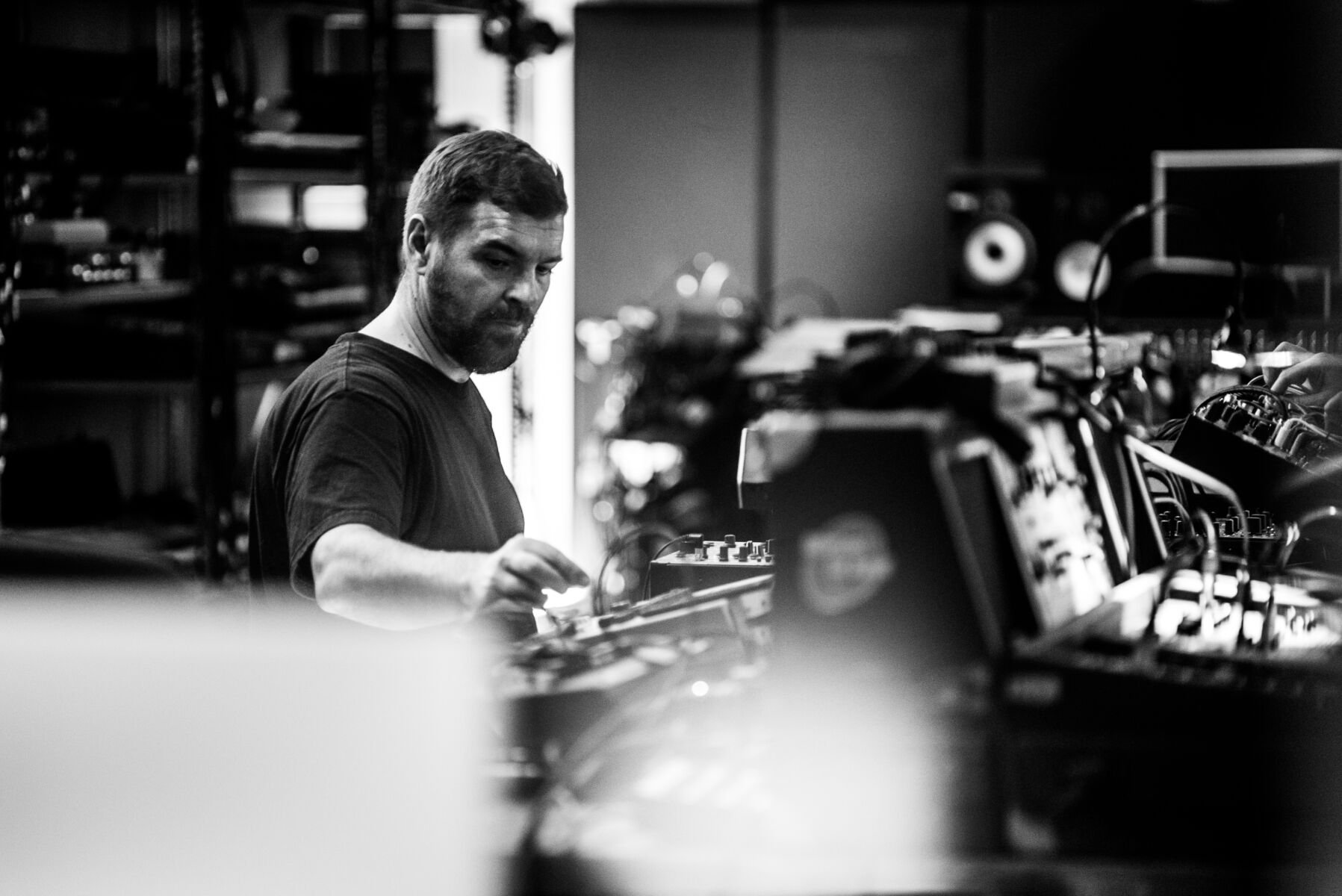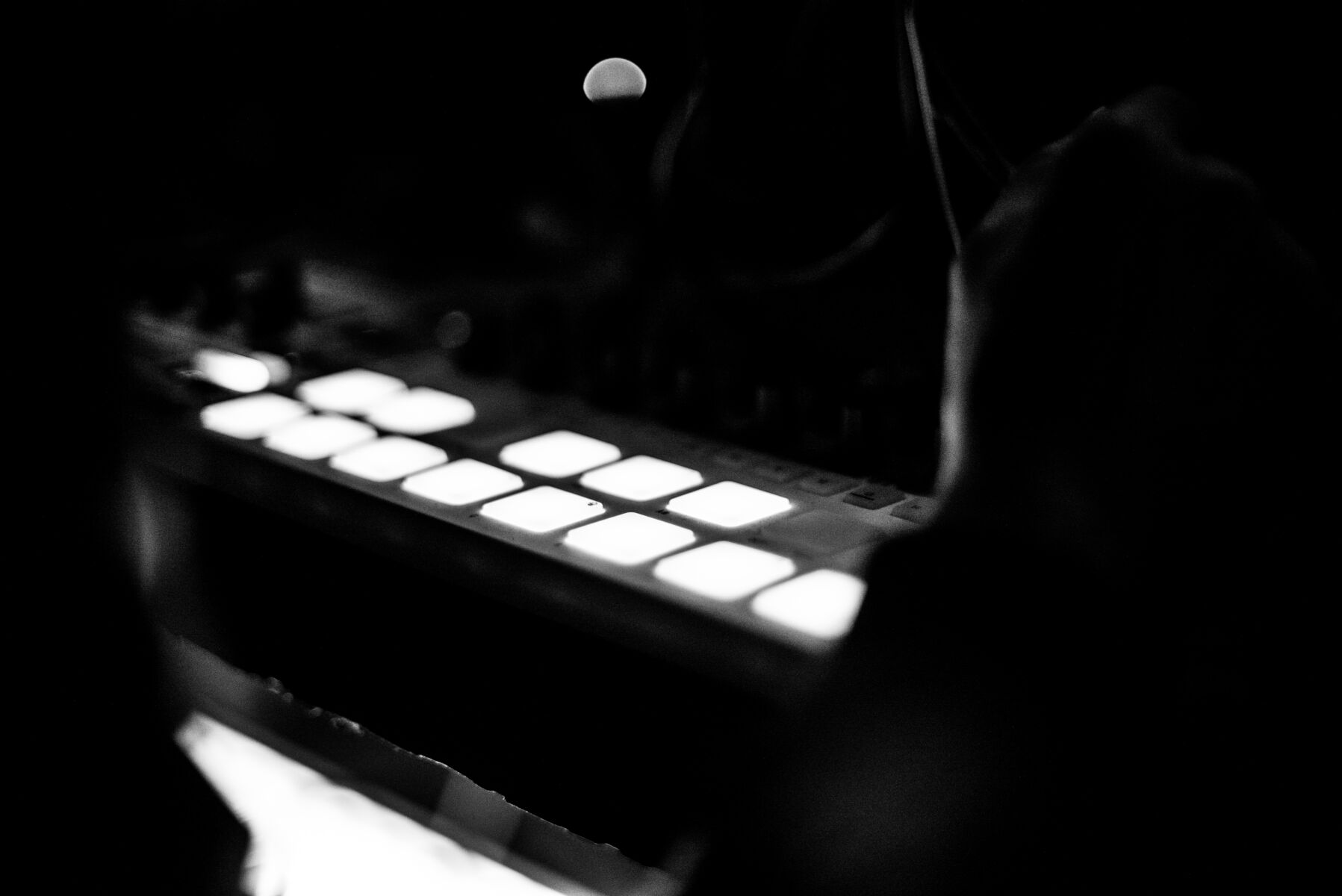Interview by Olya Karlovich

The birth of electronic music in the 1950s at the Studio for Electronic Music (WDR) in Cologne was marked by the use of precisely controlled equipment to create sound material. And as technology advanced, electronic composers became increasingly focused on the idea of perfection, efficiency and mathematical rationality1. The ability to pre-plan and control everything still attracts many artists today. However, some believe that human activity, including the listening process, is essential to even electronic music. These musicians also appeal to a wide range of sonic parameters but prefer exploration over predetermined outcomes.
Anthony Child (Surgeon) and Jochem Paap (Speedy J) are among these explorers. Despite three decades of successful careers in electronic music, they still seek the unknown, delving into the depths of improvisation in their live project, Multiples. Their joint performances, filled with anticipation and admiration for unpredictability, are like an extreme jump from a cliff into the sea, where you fully live the moment.
Child and Paap started their musical careers in the club scene, shaping the sound of techno since the 90s. However, their interests have always gone beyond dance music. By trying various performance and studio techniques, they have been pushing the boundaries of experimental electronics and skillfully balancing between the human and machine worlds.
Intuitive decision-making, improvisation, and a hands-on approach are the foundation of their solo practices and collaborations. Within Multiples, there are no limits to Child and Paap’s creative pursuits except their own imagination. They can let everything fall apart by staying open to any scenario, only to assemble new and exciting soundscapes from the resulting chaos.
Initially, Multiples was a live project. However, after a joint performance in Berlin last summer, the artists headed to Paap’s studio in Rotterdam, where they jammed non-stop for two days without any pre-agreed plans. This improvisational marathon resulted in the album Two Hours or Something, released on Paap’s STOOR label on May 17th. This one-take work combines rhythmic patterns with contemplative, beatless narratives. Exploring the bizarre territories of Two Hours or Something, it’s easy to get momentarily lost in the intricate sound structures only to discover something new and surprising.
As part of our In Conversation series, we caught up with Anthony Child and Jochem Paap to discuss their intuitive approach to music production, the creative challenges of improvisation, and the essential elements of a successful collaboration. The artists also talked about the role of the tension between man and machine in their practice and how technical limitations and working with a specific setup helped them record the Two Hours or Something album (released in May by STOOR).




Living the moment, intuitive approach in the creative process
Child: For me, it’s something that I connected with at the very beginning. I remember my parents had a HIFI system with a record player. If there wasn’t a record playing and I turned the amplifier up high, it would create feedback between the needle and the speakers. I discovered that by opening and closing the door in the room, I could change the tone of the feedback. That feels like playing an instrument — it’s all about exploration and improvisation. And I draw a line between those early experiences and what we do now.
Paap: I guess it’s similar to me. I didn’t do the feedback trick but dabbled with the HIFI equipment. Back then, everyone’s dad had a stereo system, so playing records was my first step into it [improvisation/hands-on approach].
Since then, a hands-on approach has been constant in my process. I can’t work with tedious and slow-developing things. I feel more comfortable being in the moment, just getting it out and performing it.
Even though I’ve used various recording techniques over the years, recording in real-time has always been the best way to inject feeling, emotion, and attention into music.
Child: I’ve also struggled with approaches that don’t suit me, but it’s just interesting to try them. And in the last ten years or slightly more, I’ve come back to playing with pieces of hardware in a hands-on way.
I’ve always been inspired by dub mixing production techniques — using the mixing desk, effects, and instruments and modulating things by hand. I’ve realised that’s where my biggest skill in creating music is. Plus, it’s really fun. I think we both enjoy it a lot, don’t we?
Paap: Absolutely. When you’re in the studio, it’s a non-stop judgement process. You’re constantly listening and adjusting things until you’re happy with the sound. With this hands-on approach, I’ve become very quick at knowing where I want to go. Even though some things have a huge range in the sound spectrum, this is a way to find and shape my idea.
Building stuff up from the ground with non-real-time parameters is just a fucking drag. I don’t enjoy such a process. Do you know what I mean?
Child: Yeah, I enjoy the direct way we work. Jochem, you mentioned how you like to capture a moment, and I feel the same. When you’re laying down music in real-time, you’re literally capturing that moment in a distilled form. Spreading out the time you spend on it dilutes that.
Some people could spend three years making an album and working in five different studios with full orchestration, and they can produce an amazing piece of work, but I don’t have the patience for that. I frankly like the more direct and immediate way. And we’re coming at this from a very similar mindset.
Paap: I think the excitement is also a very important factor in the whole process. Like you said, Tony, the music is unfolding in real-time, and [in such a situation] you’re both a spectator and creator. When you first hear the music that is coming from your hands or in collaboration with someone else, it sort of clicks in your head. You’re like, what’s going on? What am I hearing?
The trick is not to get overly excited so you don’t make it explode or go in a direction you don’t want. It’s about carefully balancing things. Especially when working with another person, you feel a sense of responsibility not to mess up. You contain what’s going on, but at the same time, explore where it can develop.
Child: Along with what Jochem is saying about not blowing it and containing it, there’s an important part of our live performances — and this happens in the studio as well — where we intentionally let the whole thing fall to pieces and destroy itself.
Jochem, you’ve talked before about wildly turning up and down the tempo and seeing where we end up. I enjoy that. It’s fun and exciting, not like desperately holding on to something. It reminds me of a vehicle going out of control — you let it crash and burn, then start again.
Paap: But there are two things, really. On the one hand, you are destroying what was happening, but on the other, you’re challenging yourself because no matter how the destruction lands, something else will always be present.
The machines keep running, just completely disjointed, so everything is a mess. Your brain has to make sense of the chaos and build something new from it.
Usually, the best or most interesting results come from finding your way out of this mess. You streamline and tame it, going with whatever comes out. It’s a challenge.
Collaborative improvisation and the creative process for their Multiples project
Child: I know Jochem has collaborated a frequently, and I’ve done quite a few as well. I really enjoyed that each one had such a different character. It’s me plus one other artist, and each combination creates a unique atmosphere, sound signature, mood — everything. That’s what makes them so fun. And until you try it, you don’t know exactly what’s going to come out.
Paap: Yeah. And it’s very different from what you might predict on paper. In every collaboration I’ve been involved in, it’s nothing like you’d imagine.
Putting two people together creates a third identity or entity, which overlaps with both but can be completely separate and different from what they do solo or in other collaborations.
Child: With the improvisation aspect, it’s really important to be open to what the combination [of different artists working together] is and not force it to be a premeditated idea [….]
Paap: The funny thing is we’ve been doing all these interviews, discussing the album and the [Multiples] project. But before we start making music, we never really talk about the collaboration, to be honest.
Child: Yeah, not at all.
Paap: We set up our gear together and make sure it works technically, but we don’t discuss anything in advance — how we start or where we’re going. In a club or gig environment, there are some boundaries or expectations to make it interesting for ourselves and the audience. But in the studio, there’s nothing like that. We basically press start without even talking and just see where the music takes us.
We both know how to improvise. And it’s more about listening to the other person and what’s going on, what sound comes out of the machines at that moment. That’s all we respond to. It’s all intuition and listening.
Child: It’s actually been interesting because I’ve learned something about Jochem and his process that I didn’t know. But before these interviews, when we talked a lot about improvisation, I didn’t even realise that we hadn’t discussed or verbalised anything. It makes me realise how much we trust each other.
Paap: Right. I think trust is a key aspect of any collaboration, this one as well. It’s not even a matter of confidence but trust in each other and the process. We’re both open-minded enough to be fine with things becoming whatever they become. We both have this attitude towards music that we can still make sense of it no matter how far it goes in a certain direction.
Child: Yeah, that’s good. That’s a good t-shirt slogan. Along with… What was it? Along with “Techno is a feeling”, “Trust in the process”.
Paap: No, it [Techno] is a mindset.
Child: Right. It’s a mindset and trust in the process. There you go, merchandise.
STOOR’s nights at ADE (fully improvised hardware jams between alternating musicians, led by Speedy J).
Paap: For all the STOOR live editions, I invite four other guests, with the idea that combining these particular people might create an interesting result. But you can never really tell.
Everyone participating has experience improvising or playing live. We have a video chat a week before the show to explain the technical process a bit. But when it comes to stage time, no particular person is directing the whole thing. I can technically level some things out a little, as all the signals from the musicians come to my station. But it’s very minor, and it’s rare that I do something with their sound. I’m not cutting out anybody. Having the ability to add something at any time people take their responsibility carefully.
Sometimes, there are moments when everyone is searching for where we should go next, and then, at some point, everything clicks again. I’d say the length of the sets is an advantage rather than a handicap. Everyone gets plenty of time and opportunities to step forward and do something.
Two Hours or Something and experiments with technologies in the creative process
Child: living in different countries, so it took some effort to match up our schedules. But last August, we played a gig together in Berlin, and after that, we both travelled back to the Netherlands and spent a couple of days in Jochem’s studio. That’s where we recorded all the material for the album.
[…] It just seemed like a fun idea to record something. I’ve personally never organised release campaigns and things like that. I work in a slightly haphazard way. So, it was Joachim who suggested we get together and do something. And it turned out really well.
Paap: Basically, everything we did before was live shows. But I would say that all those gigs were kind of practice leading up to the studio session. We developed the Multiples sound each time we played together by taking the collaboration further.
The whole album is essentially a two-day session. We recorded it and then selected the bits where everything clicked together.
The fine balance between Man and machine
Child: When it comes to electronic music, I like to hear the relationship and tension between the human and the machine. That’s where my favourite electronic music lies. I think that’s why we both like to be very hands-on with how we perform, physically modulating the sound and stuff like that.
Paap: You can approach playing with electronic instruments in many ways. You can plan and prepare a lot in advance, but we both like being loose between the machines and ourselves. We set up our instruments so that some of what the machines are doing is probably… I wouldn’t say random, but not completely controlled.
You don’t have to hit the drum pad every time you need a certain sound. You can program a pattern in real time to repeat it. But there’s a bit of danger involved. The machines do things you can’t completely anticipate but can still coordinate to a certain extent. It’s a pushing and pulling relationship.
Child: We’re kind of gently steering this chaos, though. That’s how I would describe it. We’re trying to tap into the present moment as directly and clearly as possible. If we wanted to be totally in control, we would probably render an audio file and play back a prepared set. But that’s boring. It wouldn’t have a connection with the present moment and the environment if we talk about a gig. And it wouldn’t connect with the audience.
Paap: If you prepare too much, it can go wrong because you have a preconceived result in mind. All that does is take away the moment’s excitement and make the whole thing susceptible to failure. You know what I mean?
Child: It’s more risky in the sense that things probably go wrong.
Paap: Yeah, yeah, yeah. And if everything is left up to the moment and dealt with in real-time, you’re way more flexible and can adjust much easier to whatever the moment requires.
Sources of experimentation
Child: What I realised afterwards was that even though we were in Jochem’s studio with all that equipment, we used the gear we perform live with to record the album, didn’t we?
Paap: Yes. We did.
Child: That’s significant to the project. We felt comfortable expressing ourselves with [those instruments].
Paap: Well, electronic instruments are just like acoustic ones. You need to practise and develop a special relationship with your instrument to become fluent and discover all its ranges. The more time you spend with it, the more you can express.
Using our live setups in the studio allowed us to be very immediate and fluent. We tried to broaden the range of our gear in a different setting from a gig, where there are audience expectations. There were no restrictions in the studio.
Child: It felt like we were exploring an alien landscape. Thinking back, it’s interesting that we didn’t even discuss connecting other equipment to the setup. We communicated through music and improvisation, not words.
Paap: Yeah, I remember only a few things… Towards the end of the sessions, we had some less busy, more droney, spaced-out pieces.
We started more rhythm-oriented, trying to capture some energy in the beginning. So, at some point, we discussed leaving more space between notes. Two or three tracks on the album came from those brief instructions. But that’s really all.
Child: I don’t remember that, but, yeah, it makes sense, though.
Paap: Even when we play live, the answer to “What shall we do?” is usually “Let’s just see what happens.” There are no plans, no words.
Child: It’s a lot of fun that way. If we planned out a set, I’d get bored quickly. I love that neither we nor the audience knows what will happen.
Paap: Exactly. And I think If we had the time this weekend, it would be another album. It would be different but still would yield a lot of new music.
Child: We should get together again.





